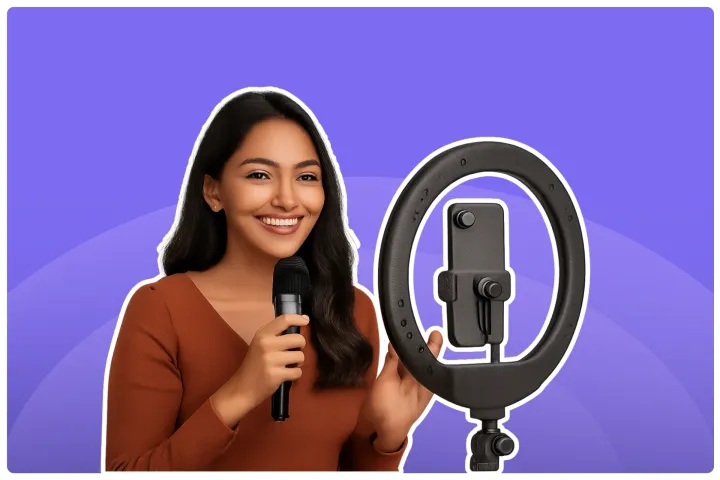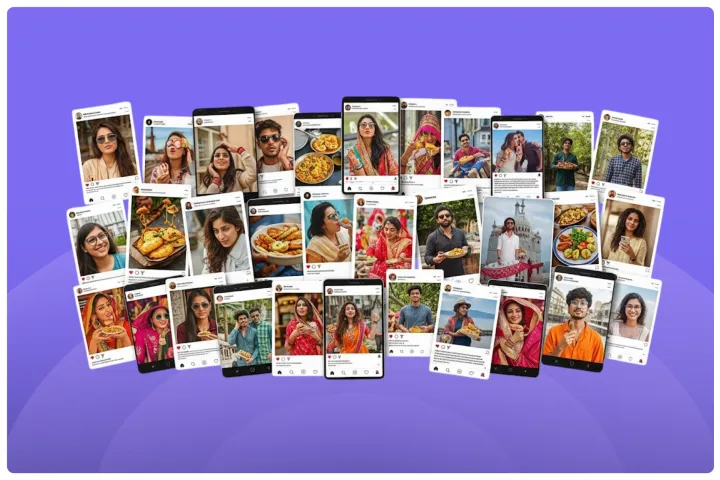Pros And Cons Of User Generated Content (2025)
Discover the pros and cons of user-generated content! Learn how it can boost engagement and its potential pitfalls for brands.
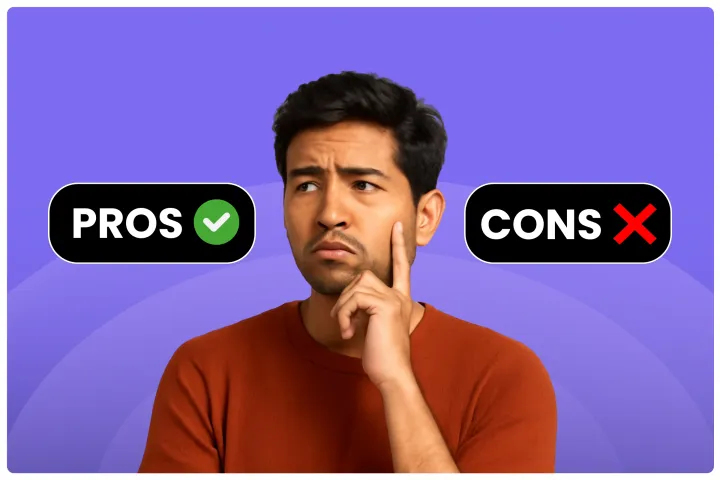
Are you trying to figure out how to get your brand's voice heard above all the noise? Wondering how to forge real, lasting connections with your customers in today's crowded market? It can feel like a tough puzzle to solve, but guess what? You already have some of the most powerful pieces right at your fingertips: authentic content created by people.
In this guide, we're going to talk all about two fantastic types of content that can seriously boost your brand: Influencer-Generated Content (IGC) and traditional User-Generated Content (UGC). We’ll break down what they are, look at their good and not-so-good sides, and, most importantly, show you how to use them together to make your marketing efforts truly shine. Think of this as your friendly manual to unlocking deeper engagement, building rock-solid trust, and ultimately, growing your business. Let's get started!
Defining the User Generated Content Types
Alright, let's first get clear on what we mean by "User-Generated Content". It's a broad term, and under its umbrella, we find a couple of key players that, while related, have distinct characteristics and roles in your marketing strategy. Understanding these differences is the first step to using them effectively.
A) Influencer-Generated Content (IGC)
So, what exactly is Influencer-Generated Content, or IGC?
Definition: Content created by individuals with a significant online following, often in collaboration with brands.
Think about those personalities you follow on Instagram, YouTube, or even LinkedIn who have a knack for creating amazing content and have built a dedicated audience. These are influencers. They could be fashion gurus, tech experts, travel vloggers, business coaches, or even local foodies with a loyal following in your city. When these individuals create content – like posts, videos, or stories – specifically to feature or promote a brand they’re partnering with, that’s IGC.
This collaboration is usually a formal arrangement. It might involve a payment (from a few thousand rupees for a micro-influencer to significantly more for larger names), a free product or service (often called a "gifted" collaboration), or an affiliate partnership where the influencer earns a commission on sales they drive. The key here is that the brand typically provides a brief or some guidelines, but the influencer uses their unique style and creativity to craft the message.
For instance, you might see a popular beauty blogger creating a stunning makeup tutorial using a specific brand's new eyeshadow palette. That tutorial, if sponsored by the brand, is prime IGC. Or a well-known chef on Instagram might post a recipe video showcasing a new brand of organic spices. That's IGC too! It’s content made by an influential voice, for their audience, with your brand taking center stage (or playing a key supporting role).
Formats: Includes sponsored posts, product reviews, unboxing videos, and tutorials.
IGC comes in many exciting shapes and sizes, designed to capture attention and engage audiences across various platforms. Here are some of a brand's favorite go-tos:
1) Sponsored Posts: This is perhaps the most common format. It can be a visually appealing photo on Instagram, a detailed post on Facebook, a witty thread on X (formerly Twitter), or a dedicated section in a blog post.
Imagine this: A fitness influencer you follow posts a picture of themselves working out in your brand's activewear. The caption talks about the comfort and style, and they include #ad or #sponsored along with your brand's tag. (This is where a screenshot of a sample Instagram sponsored post would be great!)
2) Product Reviews: Influencers often provide in-depth reviews of products or services. These can be highly persuasive because followers trust the influencer's honest opinion (even when sponsored, transparency is key!). These reviews might live on YouTube as a dedicated video, on a blog, or even as a series of Instagram Stories.
Picture this: A tech YouTuber with 200k subscribers uploads a 12-minute video titled "Honest Review: [Your Brand's New Laptop] - Worth The Hype?" They'd unbox it, test its features, and give their verdict.
3) Unboxing Videos: Who doesn't love the thrill of unboxing? These videos capture the excitement of receiving and opening a product for the first time. They are super popular on YouTube and as Instagram Reels. It’s a great way to show off your packaging and the product itself in a raw, exciting way.
Visualize an Instagram Reel: A lifestyle influencer receives a beautifully packaged gift box from your home decor brand. The Reel, set to trending music, shows them opening it, revealing each item with delighted expressions, and quickly styling a corner of their home. Short, snappy, and oh-so-shareable! 😉
4) Tutorials & How-To Content: This format is perfect for products that benefit from a demonstration. Influencers can show their audience how to use your product effectively, get the most out of it, or integrate it into their lives.
Think about it: A cooking influencer creates a "Quick Weeknight Dinner" video using your brand’s new ready-to-cook sauce, showing step-by-step how easy and delicious it is.
Other Engaging Formats: Don't limit your imagination! IGC can also include:
- Instagram Story Takeovers: An influencer "takes over" your brand's Instagram account for a day, sharing content from their perspective.
- Live Q&A Sessions: An influencer hosts a live video session discussing your product and answering audience questions in real time.
- Giveaways & Contests: Influencers can host contests on their channels where their audience can win your products, driving engagement and brand awareness.
- Purpose: To leverage the influencer's reach and credibility to promote products or services.
Why do brands invest in IGC? It boils down to a few core advantages:
1) Reach: Influencers have already done the hard work of building an audience. By partnering with them, you get to tap into this ready-made pool of potential customers – people who are likely interested in your niche if you choose the right influencer.
2) Credibility & Trust: Followers often look up to influencers and trust their recommendations, much like they’d trust a friend’s advice. When an influencer they admire endorses your product, that trust can transfer to your brand.
3) Awareness & Promotion: IGC is fantastic for getting the word out about your brand, a new product launch, or a special offer. It cuts through the noise of traditional advertising.
4) High-Quality Content: Influencers are content creators by profession. They usually have good equipment, an eye for aesthetics, and storytelling skills, meaning you get high-quality marketing assets.
5) Engagement: Influencer posts often spark conversations and interactions, which can significantly boost your brand's visibility and social media presence.
Essentially, IGC helps you borrow an influencer's spotlight and loudspeaker to tell your brand's story in a way that feels more organic and engaging than direct advertising.
B) Traditional User-Generated Content (UGC)
Now, let's shift gears to Traditional User-Generated Content, or UGC. This is the content that comes straight from your everyday heroes: your customers!
Definition: Content produced by everyday consumers or customers, typically without direct brand collaboration.
UGC is the real, unscripted, and often spontaneous love your customers show for your brand. It’s that photo someone snaps of their delicious meal at your café and posts on Instagram, the glowing review a happy buyer leaves on your website, or the video a customer makes showing off how they use your product in their daily life. The key difference from IGC is that UGC is usually created without direct payment or a formal agreement with the brand. It’s born out of genuine satisfaction, excitement, or a desire to share an experience.
Think of it as digital word-of-mouth. Someone loved your product or service so much they just had to tell their friends and followers about it. That’s the magic of UGC! ✨
Formats: Customer reviews, social media posts, testimonials, and photos.
UGC is beautifully diverse because it comes from all sorts of people in all sorts of situations. Here are common formats you'll see:
Customer Reviews: These are the bread and butter of UGC. You'll find them on:
- Your e-commerce website (e.g., "This saree is even more beautiful in person! Five stars! ⭐⭐⭐⭐⭐")
- Marketplaces like Amazon, Flipkart, Myntra.
- Review platforms like Google Reviews, Zomato, TripAdvisor.
- App store reviews.
Social Media Posts: This is where UGC truly comes alive visually!
- Customers tagging your brand in their Instagram photos or Stories (e.g., wearing your apparel, using your software, visiting your store).
- People using your branded hashtag (e.g., #MyFavorite[YourBrandName]Moment).
- Tweets or Facebook posts mentioning a positive experience with your brand.
Example: A customer posts a stunning picture of a sunset taken with their new phone from your electronics store, tagging your store and writing, "Best camera phone ever! Thanks, @[YourStoreName]!"
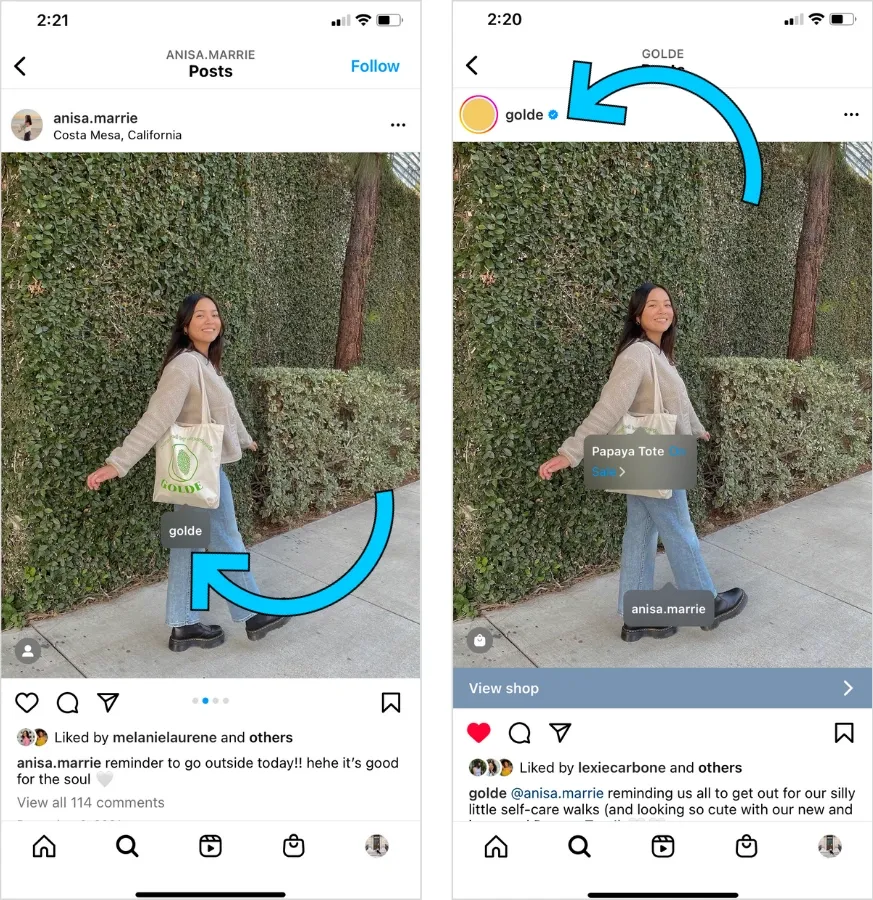
Testimonials: These can be written or in video format. While sometimes solicited (e.g., "Would you be willing to share your success story with our service?"), the content is still the customer's own words and perspective.
Imagine: A short video on your website where a small business owner explains how your accounting software saved them hours of work and helped them grow.
Photos and Videos: Customers often share images and videos showcasing how they incorporate your products into their lives.
- A home baker proudly posts a picture of a cake made using your brand's baking supplies.
- A traveler shares a video montage of their trip, featuring your brand's luggage prominently.
- Someone showing off their DIY project using your tools.
Other Forms:
- Blog Comments: Readers sharing their experiences with your product in the comments section of a relevant blog.
- Forum Discussions: People recommending your brand or sharing tips on how to use your products in online forums.
- Contest Entries: If you run a contest asking users to submit photos, videos, or stories related to your brand, those entries are valuable UGC.
- Purpose: To showcase authentic experiences and build trust among potential customers.
UGC is incredibly powerful, primarily because it's perceived as highly authentic. Here's why it's so valuable:
1) Authenticity & Trust: This is UGC's superpower. Because it comes from real users with no apparent agenda other than sharing their genuine experience, it builds immense trust. A 2023 report from Bazaarvoice highlighted that a whopping 86% of Gen Z shoppers consider authenticity crucial when deciding which brands to support. People trust recommendations from peers far more than they trust polished ads from brands themselves.
2) Social Proof: When potential customers see others like them enjoying your product or service, it provides powerful social proof. It answers the question, "If it worked for them, will it work for me?"
3) Increased Engagement & Community: Sharing UGC and interacting with customers who create it makes them feel valued and recognized. This can foster a strong sense of community around your brand.
4) Cost-Effective Content: Generally, UGC is free! Your customers are creating marketing assets for you out of their own volition. You then "just" need to get permission to reshare it.
5) Valuable Insights: UGC can give you direct insight into how customers are using your products, what they love, and sometimes, what they don't. This feedback is gold for product development and service improvement.
UGC acts as a constant stream of genuine endorsements, turning your satisfied customers into your most believable and effective marketers. It’s about real people sharing real experiences, and that’s something money can’t always buy.
Pros And Cons Of User Generated Content: Comparative Analysis
Now that we’ve got a good handle on what IGC and UGC are, let's put them side-by-side and look at their strengths and weaknesses. Like any marketing tool, neither is a perfect one-size-fits-all solution. Understanding these pros and cons will help you decide how to best incorporate them into your strategy.
A) Influencer-Generated Content (IGC)
Influencer marketing has exploded for a reason. When done right, it offers some fantastic benefits. But it’s not without its challenges.
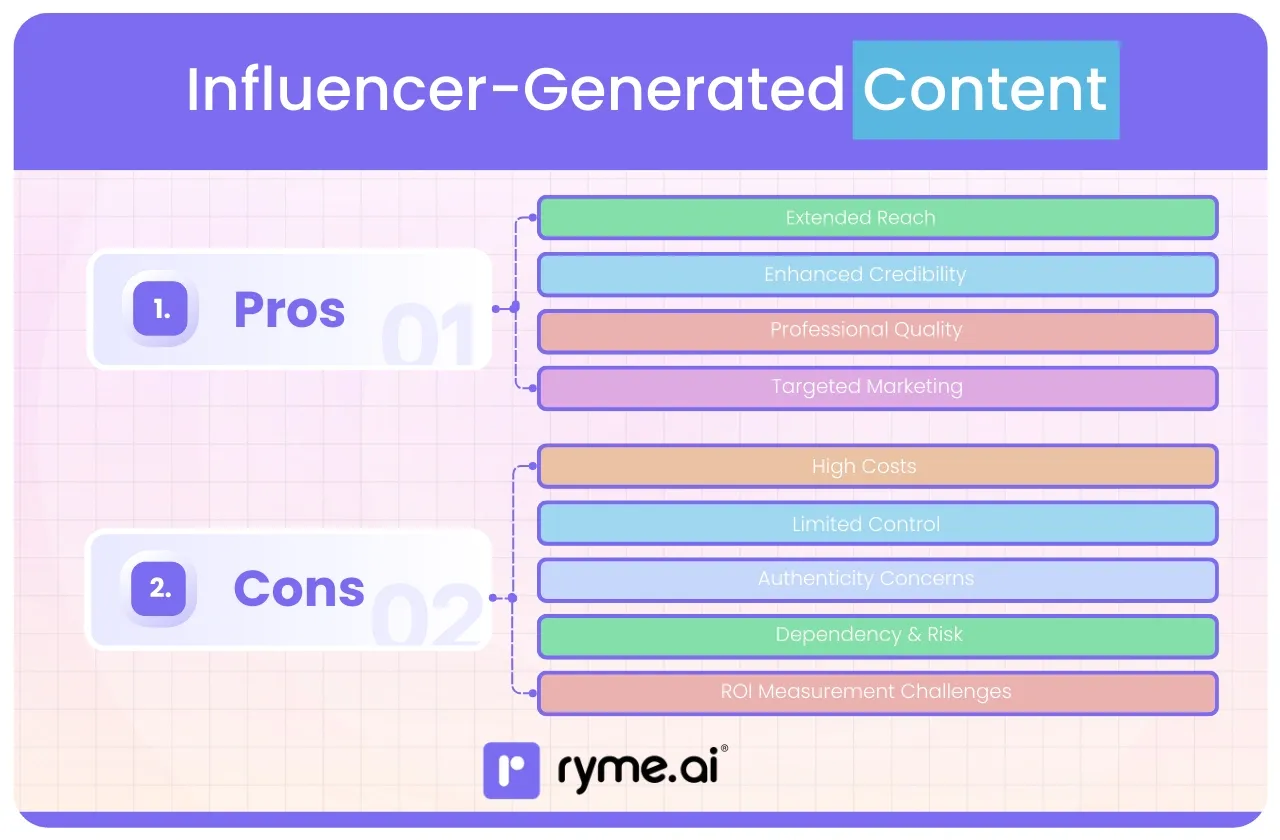
Pros:
1) Extended Reach: This is a big one. Influencers have dedicated followers, sometimes numbering in the hundreds of thousands or even millions. Partnering with them gives your brand instant access to this audience. A macro-influencer (typically 100k-1M followers) can expose your brand to a vast number of potential customers with a single post. Even micro-influencers (usually 5k-50k followers), while having smaller audiences, often boast highly engaged niche communities.
Think about it: If a popular Mumbai-based food blogger with 300,000 followers posts about your new restaurant, that's potentially 300,000 local foodies seeing your name. The Influencer Marketing Hub reported in 2023 that the industry is set to grow to approximately $21.1 billion in 2023, indicating its perceived value in reach.
2) Enhanced Credibility: Influencers often cultivate a relationship of trust with their followers. Their audience sees them as experts or relatable figures in their specific niche (be it fashion, gaming, parenting, etc.). When an influencer they trust recommends your product, that credibility can rub off on your brand.
However, this credibility hinges on transparency. Clear disclosure of sponsorship (#ad, #sponsored) is vital. According to a 2022 Sprout Social report, 30% of consumers find influencer content more authentic than brand-created content if the influencer genuinely seems to use and like the product.
3) Professional Quality: Many influencers are skilled content creators. They invest in good cameras, lighting, and editing software. They understand storytelling, aesthetics, and what makes content engaging on their specific platforms. This means you often receive high-quality, polished content that you can repurpose (with permission and agreed terms) on your own channels.
This can be a huge time and resource saver for your brand, as creating professional-level content in-house can be costly and time-consuming.
4) Targeted Marketing: This is where influencers, especially micro and nano ones, really shine. They often cater to very specific interest groups or demographics. If you sell vegan protein powder, partnering with a vegan fitness influencer ensures your message reaches an audience already interested in your product category. This precision targeting can lead to higher conversion rates.
For example, a brand selling artisanal coffee could partner with influencers known for their "studygram" or "work from home productivity" content, reaching an audience that likely consumes a good amount of coffee.
Cons:
1) High Costs: Let's be honest, influencer marketing can be a significant investment, especially if you're aiming for top-tier influencers or celebrities. Costs can range from a few thousand rupees (₹5,000 - ₹25,000) for a single post from a micro-influencer, to lakhs (₹50,000 - ₹5,00,000+), or even crores for mega-influencers and Bollywood stars. These costs don't even include product samples, agency fees if you use one, or the time spent managing the campaign.
"Getting that star cricketer to tweet about your sports drink? It'll cost a bundle! 💰 Budgeting carefully is key."
2) Limited Control: While you provide a brief, for IGC to feel authentic, influencers need a degree of creative freedom. This means you can't always dictate every word or every shot. The content will be in their voice and style. If you're a brand that likes tight control over messaging, this can be a point of friction. The more you try to control, the less authentic (and often less effective) the content may become.
3) Authenticity Concerns: Audiences are increasingly savvy. They can often spot a disingenuous endorsement from a mile away. If an influencer promotes too many products, or if a partnership feels forced and "off-brand" for them, their credibility (and yours by association) can suffer. The #ad disclosure, while legally necessary and ethically important, can sometimes make viewers inherently more skeptical. A 2023 Statista survey revealed that a significant portion of consumers find it hard to trust influencers who seem to promote anything and everything.
"If someone is raving about a new skincare line every Monday, their followers might just start tuning out. 👀"
4) Dependency & Risk: Relying too heavily on a few influencers can be risky. What if your star influencer gets embroiled in a controversy? Or what if your contract ends, and their audience was primarily loyal to them, not your brand? The positive association can vanish. It's important to diversify your marketing efforts.
5) ROI Measurement Challenges: While analytics are improving, definitively proving the Return on Investment (ROI) for every influencer campaign can still be tricky, especially for goals like brand awareness. Attributing direct sales to a specific influencer post often requires careful tracking through unique discount codes or affiliate links. Sometimes the impact is more brand lift than immediate sales, which is harder to quantify quickly.
B) Traditional User-Generated Content (UGC)
UGC is often hailed as the holy grail of authentic marketing. It has some incredible upsides, but it’s not a magic wand either.
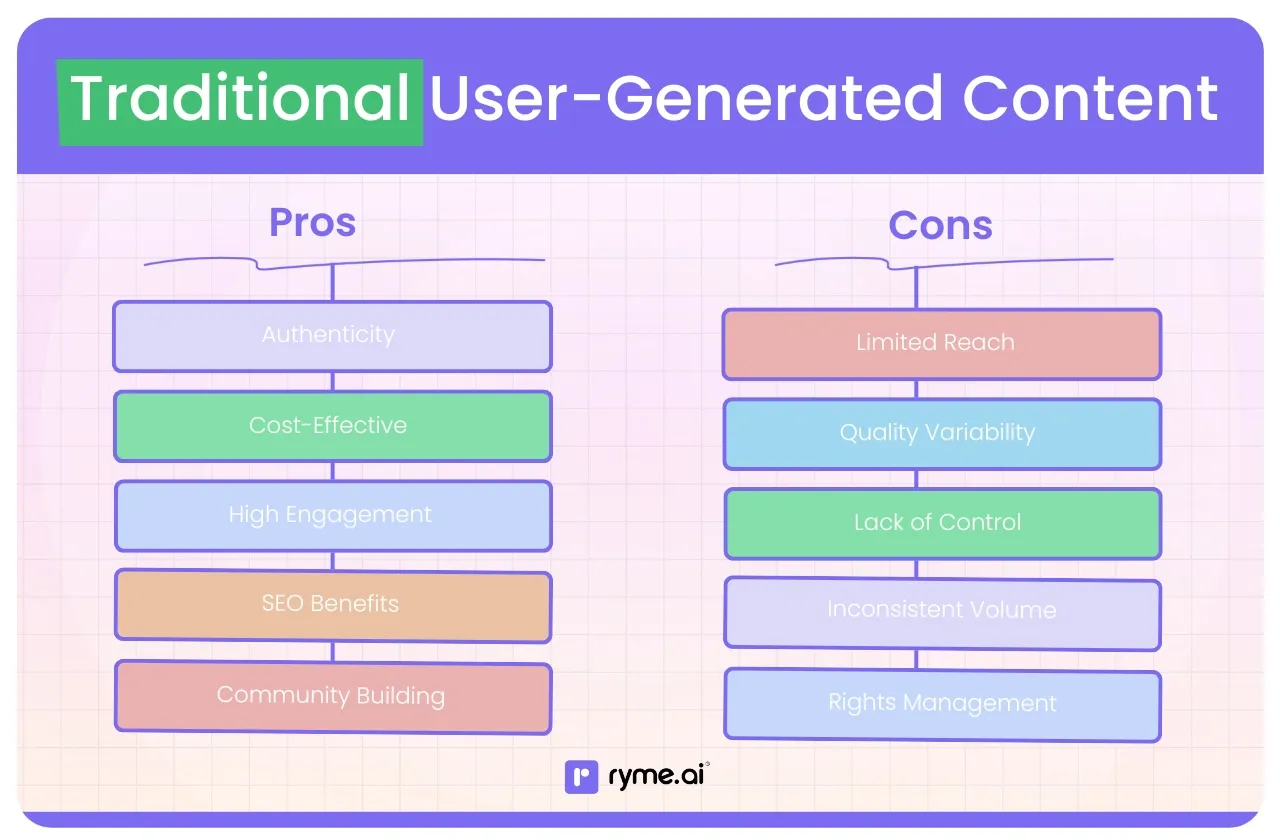
Pros:
1) Authenticity: This is UGC's undisputed superpower. Content created by genuine customers is seen as inherently more trustworthy and relatable than brand-created advertising or even some IGC. When potential buyers see real people sharing positive, unprompted experiences with your product, it builds incredible trust. Stackla's 2023 "Post-Pandemic Shifts in Consumer Shopping Habits" report found that 90% of consumers say authenticity is important when deciding which brands they like and support.
Think about it: You're looking for a new phone. Do you trust the slick TV ad more, or your friend's excited Instagram post about their great experience with that same phone? Most would lean towards the friend. BrightLocal's 2023 Local Consumer Review Survey emphasized that 76% of consumers regularly read online reviews when seeking local businesses.
2) Cost-Effective: One of the most attractive aspects of UGC is that it's often free! Your customers create and share this content because they want to, not because you've paid them. Your main "cost" is in discovering, curating, and getting permission to reshare this content, and perhaps in running campaigns or contests to encourage its creation. Compared to the potential costs of IGC or traditional advertising, UGC offers incredible value.
"Your customers are essentially becoming your volunteer marketing team! How amazing is that? 🎉"
3) High Engagement: People tend to engage more with content from their peers. UGC feels more personal and less like an interruption. When brands reshare UGC (with credit, of course!), it often sees higher engagement rates (likes, comments, shares) than overly polished brand posts. Ads featuring UGC have been known to achieve significantly higher click-through rates. For instance, a 2022 study by Comscore indicated that ads featuring UGC garnered a 5x higher click-through rate.
4) SEO Benefits: Yes, UGC can even help your search engine rankings! Customer reviews on your product pages add fresh, unique content to your site, which search engines like Google appreciate. These reviews often naturally include long-tail keywords – those specific phrases people type into search engines when they're looking to buy. More relevant content and keywords can lead to better visibility in search results and more organic traffic to your site.
"More happy customer reviews on your website could mean Google shows your products to more people searching for exactly what you offer!"
5) Community Building: Actively encouraging, collecting, and showcasing UGC can make your customers feel seen, heard, and valued. It fosters a sense of belonging and transforms customers into a community of advocates. This shared experience can lead to greater brand loyalty.
Cons:
1) Limited Reach (Initially): A fantastic piece of UGC from a customer with 200 followers might be super authentic, but its organic reach is naturally limited. For UGC to have a broader impact, your brand needs to actively discover it and amplify it through your own channels.
"Your customer’s amazing testimonial video might only be seen by their close circle unless you help give it a bigger stage!"
2) Quality Variability: Let's be real, not every customer is a professional photographer or videographer. The quality of UGC can vary wildly – from stunningly creative shots to blurry photos or poorly lit videos. This means you'll need a curation process to select the best UGC that aligns with your brand's image before resharing it.
"You'll get some absolute gems, but you might also get some pics that look like they were taken with a toaster from the 90s. 🥔 It’s all part of the charm, but curation is key!"
3) Lack of Control: This is the flip side of authenticity. Because you're not directing the content creation, you have very little control over the messaging, the visuals, or even the sentiment. Customers will share their honest opinions, and sometimes that might include constructive criticism or even negative feedback.
(Pro tip: view negative feedback as an opportunity to engage and improve!).
4) Inconsistent Volume: You can't always predict when or how much UGC you'll receive. There might be periods where you're flooded with great content, and other times when it's a slow trickle. This unpredictability can make it challenging to rely solely on UGC for consistent marketing campaigns if you don't have a proactive strategy to encourage it.
5) Rights Management: This is a big one! Just because a customer tags you or uses your hashtag doesn't automatically give you the right to use their content (especially in your ads or on your website). You must obtain explicit permission before repurposing UGC. This involves reaching out to the creator, clearly stating how you intend to use their content, and getting their consent. Failing to do so can lead to legal issues and damage your brand's reputation.
So, as you can see, both IGC and UGC bring unique strengths to the table, along with a few things to watch out for. The real magic often happens when you don't see them as an either/or choice, but as complementary tools in your marketing arsenal.
Strategic Integration: Combining IGC and UGC
Okay, team, we've unpacked IGC and UGC, and we know they both have their own unique flavors of awesome (and a few quirks). But here’s a pro tip: you don’t have to choose between them! Like a perfect biryani where all the ingredients come together, IGC and UGC can be combined to create a truly powerful and balanced marketing strategy. Let's look at how these two content types can be best buddies and work together to make your brand the talk of the town (for all the right reasons!). ✨
Think of IGC as your launch rocket – it creates the initial big splash and gets you noticed. UGC, then, is the steady-burning fuel that builds lasting trust and keeps the conversation going.
Complementary Roles: Leveraging both content types can create a balanced and effective marketing strategy.
IGC and UGC play different but equally important roles. IGC often excels at generating initial awareness, showcasing products with a professional sheen, and reaching new, targeted audiences quickly. UGC, on the other hand, shines in building trust, providing social proof, and fostering a genuine community around your brand.
Let’s imagine you're launching a new line of sustainable activewear:
Phase 1: The Big Bang (IGC-led):
Goal: Generate widespread awareness and excitement.
Action: Partner with a few well-aligned fitness and sustainable lifestyle influencers. They could create:
- High-quality Reels showcasing the new collection in action during a workout.
- Honest review videos discussing the fabric, fit, and eco-friendly aspects.
- Aesthetically pleasing Instagram posts styling the activewear for both gym and casual looks.
Impact: Their followers (your target audience) are introduced to your new line through trusted voices. This creates initial buzz and drives traffic to your website.
Phase 2: Building Believability (UGC Focus):
Goal: Build trust and encourage early adoption through social proof.
Action: Encourage early buyers to share photos of themselves wearing the activewear using a unique hashtag (e.g., #[YourBrandName]InMotion).
Run a contest: "Share how you stay active sustainably in your new #[YourBrandName] gear for a chance to be featured and win a voucher!"
Actively monitor social media for mentions and reshare (with permission!) the best customer posts, photos, and positive comments. Feature these on your product pages too.
Impact: Potential customers see real people of all shapes and sizes loving the activewear. This relatability and authenticity can be incredibly persuasive.
Phase 3: Sustained Engagement & Loyalty (Integrated Approach):
Goal: Drive ongoing sales and foster long-term brand loyalty.
Action:
- Feature compelling UGC in your targeted social media ads – it often performs better than slick corporate ads.
- Have your IGC partners occasionally engage with or highlight standout UGC, further bridging the gap.
- Continuously nurture your community by responding to UGC, thanking customers, and making them feel like part of the brand story.
Impact: You create a virtuous cycle where IGC drives initial interest, leading to purchases and UGC, which then further fuels trust and attracts new customers.
Amplification: Using IGC to reach a wider audience and UGC to build trust and authenticity.
This is where the synergy really kicks in. Influencers can be fantastic catalysts for generating UGC.
- Influencer-Led UGC Campaigns: Your influencer partners can actively encourage their followers to create content featuring your brand.
- Example: A popular DIY home decor influencer, partnering with your paint brand, could launch a challenge: "Show me your most creative DIY project using #[YourPaintBrand]! I'll feature my favorites in an upcoming video and the winner gets a ₹5000 paint voucher!"
- The influencer’s call to action provides the spark and the reach, leading to a wave of UGC that you might not have generated on your own.
- Brands Amplify UGC: Once you have this great UGC, your brand can then amplify the best pieces through your own channels (social media, website, newsletters, even paid ads – with permission, of course!). This gives the authentic customer voice a much larger platform.
"Your influencer helps get the UGC ball rolling, and then you pick up those amazing customer stories and shout them from the rooftops (digitally speaking!). 📢"
Content Repurposing: Incorporating UGC into IGC campaigns to enhance credibility.
This is a smart way to make your IGC feel even more grounded and authentic.
- Influencers Reacting to UGC: Imagine an influencer creating content where they review or react to UGC submitted by your customers.
- Example: A tech influencer could do a video titled, "You Guys Are Geniuses! Reacting to Your Awesome Setups Using #[YourBrand] Peripherals." They could showcase customer photos of their computer setups, comment on them, and offer tips. This validates the customers and makes the influencer's content more community-centric.
- Showcasing UGC within IGC: Brands can provide their influencer partners with a curated selection of high-quality UGC. The influencer can then incorporate these real-life examples into their sponsored content.
- Example: A food influencer reviewing your meal kit service could include a montage of Instagram photos from happy customers showing off the meals they’ve made, alongside their own cooking demonstration. This adds layers of social proof to the influencer's endorsement.
Community Building: Encouraging UGC to foster a sense of community and brand loyalty.
IGC can play a role here by spotlighting community members or UGC.
Your brand isn’t just about selling products; it’s about building relationships.
- Influencers as Community Champions: Influencers can act as ambassadors who not only promote your product but also engage with your customer community. They could host Q&A sessions addressing user questions, feature "fan of the week" UGC on their stories, or participate in brand-hosted community events.
- Dedicated UGC Hubs: Create spaces where UGC is celebrated. This could be a dedicated "Community" page on your website, a regular "Customer Spotlight" feature on your Instagram, or even a private Facebook group for your super-fans. When customers see their content being valued and shared, it deepens their loyalty.
"Think of it like your brand's own little hall of fame, powered by your amazing customers and cheered on
by supportive influencers. It makes everyone feel warm and fuzzy! 🥰"
The Feedback Loop: UGC informs IGC (and Product Development!)
Listen to what your customers are saying in their UGC!
- Content Clues: If many customers are posting UGC showing a specific, perhaps unexpected, way they use your product, that’s a valuable insight! You can then brief your influencer partners to create content that highlights this popular use case.
- Product Insights: UGC can also reveal what customers love most about your products, or even pain points. This direct feedback is invaluable for refining your products and messaging. If customers rave about a particular feature in their reviews, make sure your influencers know to emphasize it.
By strategically weaving IGC and UGC together, you create a marketing ecosystem that is both expansive in its reach and deeply resonant in its authenticity. It’s about starting a conversation with IGC and then letting your happy customers carry it forward with their genuine voices, creating a chorus of approval that’s hard for potential buyers to ignore.
ryme.ai: Empowering Brands with AI-Driven Influencer Collaboration
Now, you might be thinking, "Okay, I'm sold on influencer marketing, but finding the right influencers, managing campaigns, and not breaking the bank... that sounds like a lot of work!" And you're right, it can be, especially if you're trying to do it all manually. It can feel like searching for a needle in a haystack while juggling flaming torches. 🔥🤹♂️
But what if there was a smarter way? A way to take the guesswork and a chunk of the heavy lifting out of influencer collaborations? That's where innovative platforms come into play. Let me introduce you to ryme.ai.
Platform Overview: ryme.ai is an AI-powered influencer collaboration platform designed to streamline the process of connecting brands with creators.
In simple terms, ryme.ai acts as your super-smart assistant for influencer marketing. It uses the power of Artificial Intelligence (AI) to make the whole process – from finding the perfect influencer to measuring your campaign's success – smoother, faster, and more effective. No more endless scrolling through Instagram profiles or relying on gut feelings! Ryme.ai aims to bring data-driven precision to your influencer strategy, making it easier for you to launch successful campaigns.
Key Features:
So, what makes ryme.ai stand out? Let's look at some of its cool features that can really help your brand:
1) Zero Commission & No Minimum Budget: Making influencer marketing accessible for brands of all sizes.
This is a game-changer, especially for small and medium-sized businesses (SMBs) or startups in India. Traditionally, working with influencer marketing agencies or some platforms involved hefty commission fees (a percentage of your spend) or required you to commit to a large minimum campaign budget. This could make influencer marketing feel out of reach if you were just starting or had a more modest marketing spend.
Ryme.ai breaks down this barrier.
Zero Commission: This means the platform doesn't take a cut from your payments to influencers. More of your budget goes directly into the campaign itself, maximizing your ROI.
No Minimum Budget: Whether you have ₹10,000 or ₹10,00,000 for your campaign, ryme.ai is designed to accommodate you. You can start small, test the waters, and scale up as you see results. This flexibility is fantastic for businesses that want to be smart and cautious with their marketing spends.
"Imagine being able to dip your toes into influencer marketing with a budget that feels comfortable for you, without worrying about platform fees eating up a big chunk of it. That’s more money for creating awesome content! 🥳"
2) AI-Powered Influencer Matching: Ensuring brands connect with the right influencers based on real data.
This is where the "AI" magic really happens. Finding the right influencer is crucial for campaign success. You need someone whose audience genuinely aligns with your target customers, whose content style fits your brand, and who has real engagement (not just a high follower count bought from who-knows-where).
ryme.ai's AI engine works behind the scenes to:
Analyze vast amounts of data from influencer profiles.
Look beyond just follower numbers: It considers factors like engagement rates (likes, comments, shares relative to audience size), audience demographics (age, location, interests of the influencer's followers), content quality and style, previous campaign performance, and even potential brand affinity.
Match your brand with influencers who are most likely to deliver results based on your specific campaign goals and target audience.
"No more guessing games or picking an influencer just because they seem popular. Ryme.ai uses its data smarts to find influencers whose followers are the people you actually want to reach. It’s like having a data scientist dedicated to your influencer search! 🤓"
For example, if you're a brand selling sustainable fashion in Bangalore, ryme.ai's AI would sift through creators to find those who genuinely focus on eco-conscious living, have an engaged audience in Bangalore, and whose aesthetic matches your brand – not just any fashion influencer.
3) Robust Analytics & Reporting: Providing real-time performance data to optimize campaigns.
"What gets measured, gets managed." This is so true for marketing. You need to know how your influencer campaigns are performing to understand your ROI and make informed decisions for future efforts.
ryme.ai provides tools to:
Track key performance indicators (KPIs) in real-time or near real-time. This could include reach (how many people saw the content), impressions (how many times it was seen), engagement (likes, comments, shares, saves), click-through rates (if a link was provided), and potentially even conversions or sales if tracking is set up (e.g., via unique promo codes or UTM parameters).
Generate clear reports that show you what's working and what might need tweaking.
"Forget waiting weeks for a complicated spreadsheet. With robust analytics, you can see how your campaign is doing as it happens. Are people loving the content? Are they clicking your link? This helps you make smart adjustments on the fly and prove the value of your investment."
4) Seamless Collaboration Tools: Facilitating smooth workflows between brands and influencers.
Managing influencer campaigns, especially if you're working with multiple creators, can involve a lot of back-and-forth communication, contract negotiations, content approvals, and payment processing. It can get messy quickly!
Ryme.ai aims to simplify this with integrated tools for:
- Communication: A centralized place to chat with influencers, share briefs, and discuss content ideas.
- Brief Sharing: Easily upload and share your campaign brief, ensuring influencers have all the necessary information.
- Content Approval: Streamlined workflows for reviewing and approving influencer content before it goes live.
- Payment Processing: Secure and straightforward payment systems.
"Say goodbye to endless email chains, lost DMs, and chasing invoices! r yme.ai helps keep all your influencer collaboration details organized in one place, making the whole process smoother and less stressful for both you and the creators."
By offering these features, a platform like ryme.ai can empower your brand to not only participate in influencer marketing but to do so more efficiently, intelligently, and cost-effectively. It helps level the playing field, allowing even smaller brands to harness the power of influencer voices without needing a massive marketing department or budget. It’s about making smart, data-backed IGC a reachable goal.
User Generated Content: Best Practices for Brands
Alright, let's get down to brass tacks! You're excited about the potential of IGC and UGC (and maybe even checking out ryme.ai!). But how do you actually put these strategies into action effectively? Just diving in without a plan can lead to wasted effort and missed opportunities. Don't worry, I've got your back with some tried-and-true best practices to help you navigate this exciting space like a pro. 👍
Think of these as your friendly guiding principles for getting the most out of your content collaborations and community engagement.
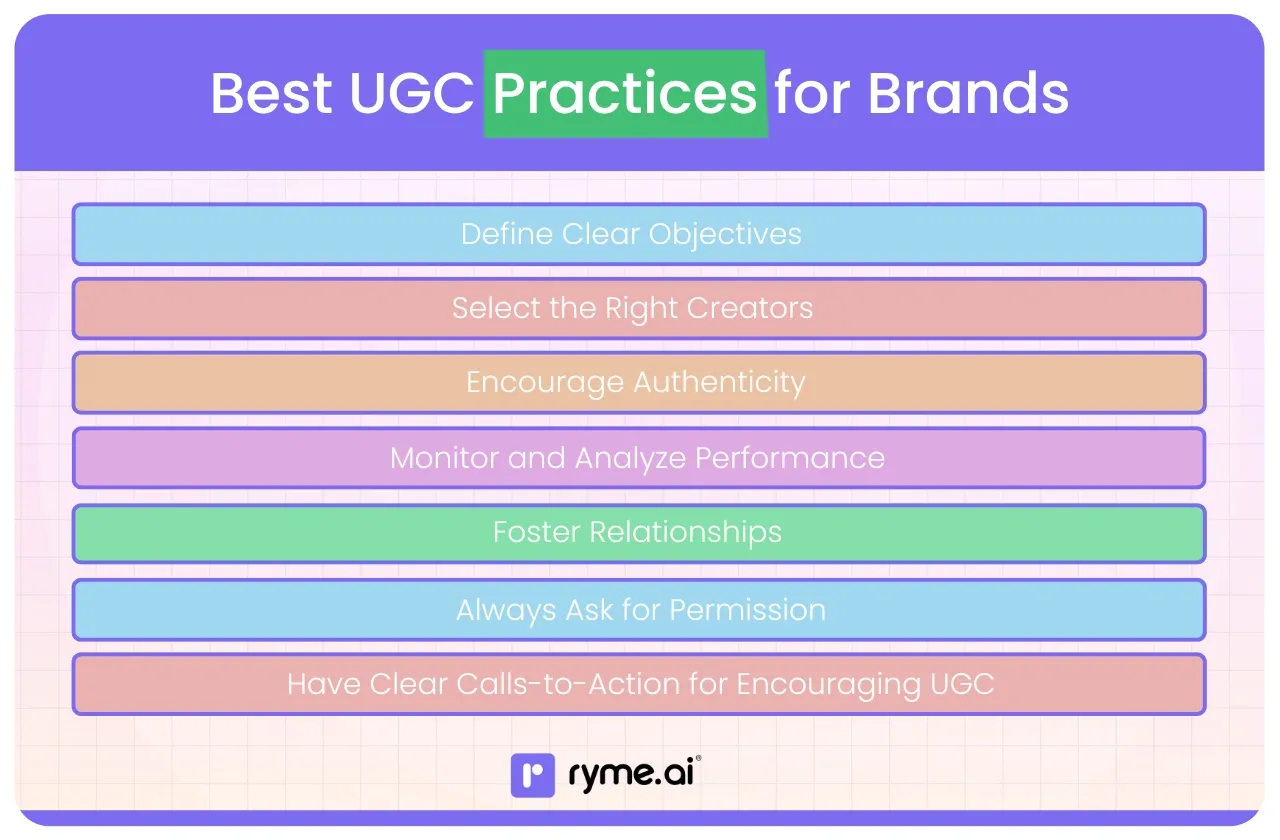
1) Define Clear Objectives: Understand what you aim to achieve with IGC and UGC.
Before you even think about hashtags or influencers, ask yourself: What do we want to achieve? Your goals will shape every other decision you make.
- Are you looking for Brand Awareness? Maybe you're a new brand or launching a new product, and your primary goal is just to get your name out there. In this case, reach and impressions might be your key metrics. IGC with influencers who have larger, relevant audiences could be a good fit.
- Is it about Building Trust and Credibility? Perhaps your brand is in a skeptical market, and you need to show authenticity. Here, showcasing genuine customer reviews and testimonials (UGC) would be paramount.
- Do you want to Drive Leads and Sales? Ultimately, most businesses want to increase sales. Your campaigns should then focus on clear calls-to-action, trackable links, and perhaps special offers. Both IGC (with direct response elements) and UGC (like reviews on product pages) can contribute here.
- Is Community Building a Priority? Do you want to foster a loyal following around your brand? Then encouraging UGC, running interactive campaigns, and highlighting customer stories will be key.
- Action Tip: Write down 1-3 specific, measurable, achievable, relevant, and time-bound (SMART) goals for your IGC/UGC efforts.
- For example: "Increase Instagram engagement by 15% in the next 3 months by encouraging UGC through a branded hashtag contest." or "Generate 50 qualified leads from our IGC campaign with micro-influencers in the finance niche within 6 weeks."
"Don't just 'do' content marketing. Know why you're doing it. Your 'why' will be your compass! 🧭"
2) Select the Right Creators: Use platforms like ryme.ai to find influencers that align with your brand values.
For IGC, choosing the right influencer is more than just looking at follower counts. You need someone whose audience matches your target demographic, whose content style resonates with your brand, and who genuinely aligns with your brand's values.
- Look Beyond the Numbers: High follower count is nice, but engagement rate (likes, comments, shares per post relative to followers) is often a better indicator of a truly connected audience. An influencer with 10k highly engaged followers in your niche can be far more valuable than one with 100k disengaged followers.
- Check for Authenticity: Do they seem genuine? Do they interact with their followers? Look at their past sponsored content – does it feel natural or forced?
- Brand Values Alignment: This is crucial. If you're an eco-friendly brand, partnering with an influencer who constantly promotes fast fashion will create a disconnect and could harm your credibility.
- For UGC, identify your existing advocates: Who are the customers already posting positively about you? These are your potential super-fans. Nurture these relationships!
- Action Tip: Create an "ideal influencer persona" for your brand, just like you have an ideal customer persona. What are their characteristics? What topics do they cover? What's their tone? Then use tools like ryme.ai (with its AI matching) or manual research to find individuals who fit this persona.
"It’s like casting for a movie – you need the right actor for the role! 🎬 Your influencer should be a natural fit for your brand's story."
3) Encourage Authenticity: Allow creators the freedom to produce content that resonates with their audience.
This applies to both IGC and UGC.
- For IGC: Provide a clear brief with your key messages, campaign goals, deliverables, and any mandatory disclosures (like #ad). However, avoid overly prescriptive scripts or demanding excessive control over the creative process. Influencers know their audience best and what kind_of content will resonate. Micromanaging can stifle creativity and lead to content that feels robotic and inauthentic. A 2023 HubSpot blog highlighted that the effectiveness of influencer marketing often lies in its ability to enable authentic storytelling.
- For UGC: Make it super easy and inviting for customers to share their experiences.
- Create a simple, memorable branded hashtag (e.g., #[YourBrandName]Style, #[YourBrandName]Eats).
- Run contests or offer small incentives for sharing (e.g., "Share a photo with your new [product] using #[OurHashtag] for a chance to be featured on our page!").
- Simply ask! After a positive interaction or purchase, you can gently encourage customers to share their feedback or photos.
- Action Tip: When briefing influencers, focus on the "what" and "why" but give them flexibility on the "how." For UGC, make your calls-to-action clear, fun, and rewarding.
"Give your creators (both paid influencers and happy customers) some creative breathing room! 🎨 Their genuine enthusiasm is what makes their content so powerful."
4) Monitor and Analyze Performance: Regularly assess the effectiveness of your campaigns to make data-driven decisions.
Don't just launch and forget! You need to track how your IGC and UGC initiatives are performing against the objectives you set.
- Key Metrics for IGC: Reach, impressions, engagement rate, click-through rate (CTR) to your website, conversions (if using promo codes or affiliate links), cost per engagement, ROI.
- Key Metrics for UGC: Volume of UGC generated, sentiment (is it positive, negative, neutral?), engagement on reshared UGC, usage of your branded hashtag.
- Tools: Use platform analytics (Instagram Insights, YouTube Analytics), Google Analytics, and the reporting features within platforms like ryme.ai.
- Action Tip: Schedule regular check-ins (e.g., weekly or bi-weekly during an active campaign) to review your metrics. What content formats are performing best? Which influencers are driving the most engagement? Is the sentiment of UGC positive? Use these insights to optimize current campaigns and plan future ones.
"Keep an eye on those numbers! 📊 They tell you what’s working, what’s not, and where to steer your ship next."
For instance, if you're a travel company and find that influencer videos showcasing "hidden gems" get far more engagement than hotel reviews, you'll know to focus more on experience-based content.
5) Foster Relationships: Build long-term partnerships with creators to ensure sustained success.
Think beyond one-off campaigns. Building genuine, long-term relationships with influencers who consistently deliver great results and truly love your brand can be incredibly valuable. They become true brand ambassadors.
- For Influencers: Treat them as partners, not just transactional vendors. Communicate clearly, pay them fairly and on time, and show appreciation for their work.
- For Customers Creating UGC: Acknowledge and appreciate their efforts! A simple "thank you," a feature on your page (with permission!), or even a small surprise discount can go a long way in making a customer feel valued and encourage them to continue advocating for your brand.
- Action Tip: Identify your top-performing influencers and most enthusiastic customer advocates. Think about how you can build ongoing collaborations or loyalty programs with them.
"It’s about building a tribe! 🤝 Treat your creators and advocates like the VIPs they are, and they'll be more likely to stick with you and sing your praises for the long haul."
6) Always Ask for Permission (Especially for UGC!):
This cannot be stressed enough. Just because someone tags your brand or uses your hashtag does not automatically grant you the legal right to use their photo, video, or text in your marketing materials (especially ads or your website).
- Process: Reach out directly to the creator (a DM on social media often works). Clearly explain how and where you’d like to use their content. Ask for their explicit permission. It's good practice to mention you'll give them full credit.
- Why it Matters: It respects their intellectual property, avoids legal trouble, and maintains a good relationship with your community.
- Action Tip: Create a template message for requesting UGC permissions. Something like: "Hey [Username]! We absolutely LOVE your photo/video featuring our [product]! 😍 Would you mind if we shared it on our official [Platform, e.g., Instagram page] and possibly on our website? We'll be sure to give you full credit, of course! Let us know if that's okay."
7) Have Clear Calls-to-Action (CTA) for Encouraging UGC:
If you want your customers to create content, you often need to guide them!
- Be Specific: Instead of a vague "Share your thoughts," try something more targeted: "Show us your favorite way to style our new kurta! #My[Brand]KurtaStyle" or "What's the first dish you cooked with your [Brand] spice mix? Share a pic with #[Brand]FirstMeal!"
- Incentivize (Sometimes): Contests, giveaways, or the chance to be featured can significantly boost participation. "Best photo using #[OurProduct] this month wins a ₹2000 voucher!"
- Action Tip: Brainstorm 2-3 fun and engaging UGC campaign ideas with clear CTAs and relevant hashtags for your brand. Think about what would genuinely motivate your customers to participate.
By following these best practices, you'll be well on your way to creating impactful IGC and UGC strategies that not only look good but also deliver real results for your brand. It’s about being intentional, authentic, and community-focused.
Conclusion
So, there you have it! Your friendly deep dive into the exciting avenues of Influencer-Generated Content (IGC) and User-Generated Content (UGC). We've seen how IGC can offer incredible reach and professional polish, while UGC brings that unbeatable punch of authenticity and trust, straight from the heart of your customer base.
It might seem like a lot to take in, but the core message is simple: authentic voices build powerful brands. Whether it's the carefully crafted narrative of an influencer who genuinely connects with your product, or the spontaneous shout-out from a delighted customer, these forms of content help you build bridges of trust and relatability with your audience in ways that traditional advertising often can't.
Remember, you don’t necessarily have to choose between IGC and UGC. In fact, the smartest strategies often involve a blend of both, letting them play to their unique strengths. IGC can light the spark and broaden your horizons, while UGC can fan the flames of community and solidify belief in your brand. And with platforms like ryme.ai making influencer collaborations more accessible and data-driven, even brands with tighter budgets can start making a real impact.
